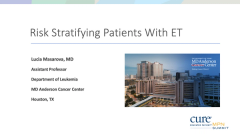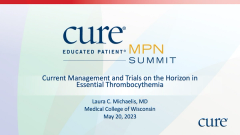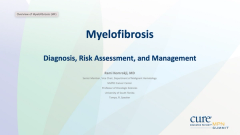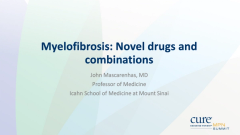
Educated Patient® MPN Summit Myelofibrosis Panel: May 20, 2023
Watch Dr. Rami Komrokji and Dr. John O. Mascarenhas answer questions about myelofibrosis during the CURE® Educated Patient® MPN Summit.
Episodes in this series

This panel was moderated by Brielle Benyon, and included Dr. Rami Komrokji, from Moffitt Cancer Center, and Dr. John O. Mascarenhas, from Icahn School of Medicine.
Benyon: The first (question) is how often should next generation sequencing testing or bone marrow biopsy be conducted in patients with myelofibrosis over the course of their disease? And are there of triggers that would initiate these tests? Or do you recommend annual testing?
Komrokji: Sure, so I can try to answer that. And John can probably add if I miss something. So I think obviously, those are essential at time of diagnosis. So for us to diagnose the disease, we need the bone marrow, like probably even there was some discussion about this in the PV and ET. Although sometimes in PV and ET we can make the diagnosis, it's a good idea to get them because the line between those diseases, sometimes it's fine, and the fibrosis could be present there. But for us to establish the presence of the myelofibrosis or the early stage of it, we need the bone marrow test to be done. The molecular testing, which we refer to as next generation sequencing, allow us to sequence several genes in one set. And that can actually be done either on the bone marrow or on the peripheral blood. There are other ways to look at the JAK2. But the NGS now is accepted as probably a universal way to look at many mutations. As I mentioned, those are like what we call the phenotype drivers. So they drive a lot of the disease. But there are other mutations that next generation sequencing or profile include that are important as prognostic factors as well. So I'd say typically, usually we do them at the time of diagnosis. And that's very essential. Is there a role to repeat them during the course of the disease? Not necessarily, just at random point, I would say obviously, what guides that is the clinical manifestation. So if patients have new symptoms, if there was change in the blood counts, if we start seeing leukemia cells in the blood, those usually are triggered. Sometimes if we are doing treatments, particularly if we think that can modify the disease, we may repeat those at certain time points after the treatment to assess it. But in my opinion, there is no value of keeping doing bone marrows every six months without any clinical indication or assessment or response on a treatment.
Benyon: Thank you. And Dr. Mascarenhas, we talked a little bit about momelotinib, if that's approved by the FDA, how long does it typically take for drugs to be available in clinical practice after they're approved? So you know, what's the typical lag time we can see from approval to production and then availability to the patients?
Mascarenhas: So it can vary, it depends on the drug, the manufacturer and the circumstances surrounding its approval. There's a date called the PDUFA date, that is typically when the FDA will announce the approval in the agreement to move forward with the drug. And then there's a scramble. And what happens is, it usually takes several weeks, at a minimum, in my experience, it sometimes takes you know, well over a month for the drug to not typically get approved, but to be a commercially available and for, you know, for like insurance companies and specialty pharmacies to have access to that in order to distribute it to the patient. So there's sometimes a frustrating lag, it doesn't happen the next day, it can take several weeks, at least, if not a month or so. But there's a lot of interest to make that faster. And the companies as they're getting closer and closer, they are revving up and getting ready for this too. So you're trying to get their team out into the field and make sure that pharmacies and institutions, etc are aware of the drug and can start to stock the drug to get into patients. But it doesn't take years.
Benyon: That's good to hear. Thank you. Dr. Komrokji, for younger patients who are diagnosed with myelofibrosis, let's say under the age of 55, is there a greater chance for their disease to transform into AML, regardless of genetics, just because they're younger and they're living longer with the disease?
Komrokji: Yeah, I think in a way, yes. Obviously, you know, we have certain factors that predict the progression of the disease, as I mentioned, mostly molecular profile of the disease. But in many cases, it's also a function of time. At time of diagnosis, we have some uncertainty, what's going to happen down the road in terms of the clonal stem cells, their stability, what will be other extrinsic or intrinsic factors that affect that. But in general, yes, like, obviously, it takes time, 15 to 20 years. So we do think of the disease differently in the younger patients. So if I have somebody who's 50, even if they are a borderline higher risk, we may start thinking about the timing of allogeneic stem cell transplant. You don't want to go too early to take that excess side effects of the transplant and, you know, mortality by also don't want to go late when the disease is going to leukemia. So definitely younger patients who are more on the look for that we send them earlier to transplant, get everything ready. And then we keep monitoring closely to decide on the optimal timing. If they're on the higher-risk side, we are more likely to go to transplant earlier, like somebody who's 75, or something like that.
Benyon: Great, thank you. And our final question is for Dr. Mascarenhas, or either of you can jump in certainly. Patients may have a family history of myeloproliferative neoplasms. Are these diseases genetic? And if so, are those genetic and family histories taken into consideration when determining treatment and such?
Mascarenhas: It's a great question, it comes often. And so words matter sometimes in the sense that, yes, they are genetic, because there's a genetic basis to these diseases. There are mutations or alterations in the genes in the blood cells and the stem blood cells that drive the disease. The real question is, are they congenital? Are they born with them or not? And the reality is the majority of patients that we see are not born with an MPN. They're not born with any of these types of diseases at birth. But there is actually really interesting data from the United Kingdom, researchers that demonstrated through very sophisticated modeling from patient samples that mutations likely arise in some patients very early on maybe even in utero, so they're acquired. So they're not inherited. But they're acquired. I believe that there's probably an inherited increased predisposition to acquiring the mutations, meaning someone has some genetic background that that predisposes them to developing these mutations for reasons we do you not understand. And you can have a family of six siblings and one person has it and the other five at the same food, drank the same drinks, lived in the same house, don't have that disease. We don't know why. We think maybe infections, inflammation, other life events may influence that and influence the acquisition of these mutations. But we know that there's an increased susceptibility to acquiring these in family members. If you have a first-degree relative. With someone who has a MPN, you're more likely to develop it, you're still unlikely to develop it. But you're more likely than the family next door that doesn't have a family history of an MPN. And we simply don't understand why.
Does it help with the formulation of a treatment plan? I would say no, not really, I don't think our knowledge base is sophisticated enough to factor that into decision-making. The decision-making for treatment, as Rami has pointed out, and I hope I've also illustrated, it should be very personalized to the patient. It doesn't necessarily take into account other family members who have the disease, although that's always important, I think, to share with the physician, because it might cause us to look more carefully. For example, if you send someone to transplantation and there are family members who have you know, related diseases, we really need to make sure that those family members that are being considered for transplant, giving the bone marrow cells, have been tested for mutations that can occur in the bone marrow that might not even manifest as diseases at that point. Because you wouldn't want to transfer disease cells, it would kind of defeat the purpose. And that becomes an important consideration. And now that we have the sequencing techniques, we can sequence of blood cells from donors, and we can make sure that they don't silently harbor mutations that would be deleterious to give to the recipient. So it does factor in in that way.
Transcription edited for clarity.
For more news on cancer updates, research and education, don’t forget to












